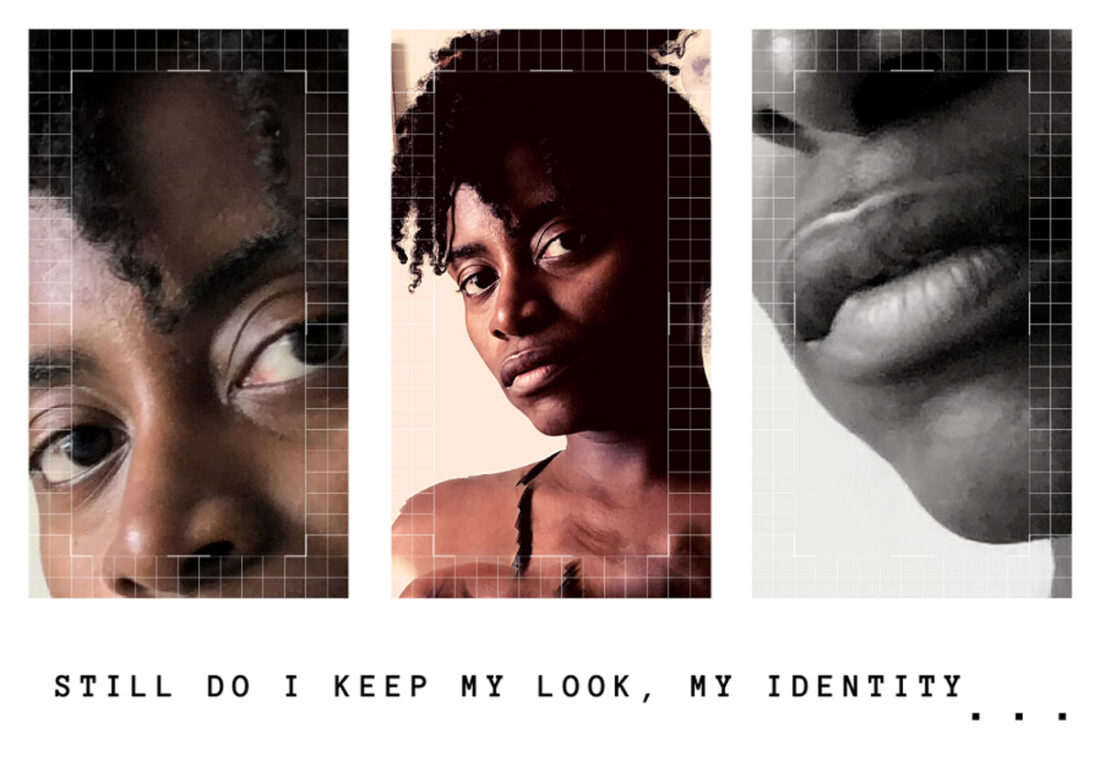
Still Do I Keep My Look, My Identity…
Still Do I Keep My Look, My Identity...is an independent digital project by Tayina Deravile celebrating works by Black artists from the collection of Francie Bishop Good and David Horvitz. Inspired by a poem of the same name by Gwendolyn Brooks, Tayina recognizes select pieces from the collection by Black artists....
Creating and developing this curatorial project has been a practice in self care. I have been able to analyze my appreciation of artworks by some of the Black artists in the collection. This project is inspired by the poem Still Do I Keep My Look, My Identity... by Gwendolyn Brooks, and by Girls’ Club’s mission to educate, act as a resource, and nurture the careers of contemporary female artists. Black Lives Matter, therefore it is incredibly valuable to highlight the complex representations of Black identity within the collection.
Given the current political climate, the importance of elevating Black voices is a direct call to action in response to anti-Black racism. While there has been some increased recognition of years of discrimination and systemic racism within the art world, further progress is needed.
I selected works in the collection by female identifying artists that examine identity through the Black experience. This project is in celebration of great work by artists I have admiration for. This is my humble attempt at recognizing their talent and prominence.”
Juneteenth, celebrated annually on June 19th, commemorates the anniversary of the last enslaved people of the United States. Although President Abraham Lincoln enacted the Emancipation Proclamation to take place on January 1, 1863, which freed all previously enslaved people, some Confederate states did not comply. On June 19, 1865, Major General Gordon Granger and Union soldiers rode to Galveston, Texas and read the federal order to declare all previously enslaved people in Texas were free. Today, Juneteenth is a celebration of African American freedom.
In celebration of Juneteenth, Girls’ Club presents Still Do I Keep My Look, My Identity..., an independent project by Tayina Deravile:
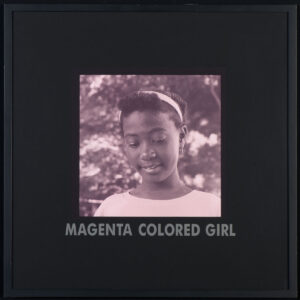
Carrie Mae Weems
Magenta Colored Girl, 1989-90
Color Photograph
30 x 30 inches
Collection Francie Bishop Good and David Horvitz, promised gift to NSU Art Museum
Carrie Mae Weems
The first piece that I chose in this digital project is Magenta Colored Girl by Carrie Mae Weems. This portrait is one photograph in Weems’ Colored People series (1987–90) which features portraits of Black adolescents in a spectrum of tinted hues. Word playing off of the antiquated term “colored girl” Weems investigates colorism in the Black community and its effects on the youth.
Colorism is a result of anti-Blackness that dates back to chattel slavery and progressed as a discriminatory practice. Proximity to whiteness, i.e. lighter skinned Africans or mixed raced Africans were given more privilege than darker enslaved Africans. This practice of discrimination continues through systemic barriers of resources, accesses and privileges. (Landor and Smith 2019)
The Black community developed descriptors to categorize shades of Blackness. This photographic series explores some of those terms as it results in internalized attitudes of the youth. Carrie Mae Weems described that these were narratives of “when issues of race really begin to affect you, at the point of an innocence beginning to be disrupted...”- Carrie Mae Weems (Lane 2014).
Magenta Colored Girl is one of my favorite pieces in the collection. As a multidisciplinary artist, Weems’ works push the narrative of contemporary art by investigating the cultural value of Black feminism, identity and race. What draws me immediately in the photograph, is the subject, a dark skinned young girl. The bright magenta dye compliments this young girl, who gazes down, with an almost smile.
I identify so much with this photo because I think about young Tayina. I think about the benefit this photo would have had on me as a young child, maybe on a school field trip to a museum or in the brief survey of art history taught to me in K-12. I also think about the benefit of other children seeing someone who looks like them adorned on the walls or in a text book. As a dark skinned woman, I have faced instances of colorism, discrimination and racism all my life and although it does not fix the hate, it is validating to see this representation. Inclusion and representation matters. Period.
Bibliography + Additional Resources
- Brooks, Gwendolyn. “Still Do I Keep My Look, My Identity...” Poetry: A Magazine of Verse, Nov. 1944, p. 76, www.poetryfoundation.org/poetrymagazine/browse?contentId=23989.
- Cotter, Holland. “Testimony of a Cleareyed Witness.” The New York Times, The New York Times, 23 Jan. 2014, www.nytimes.com/2014/01/24/arts/design/carrie-mae-weems-charts-the-black-experience-in-photographs.html.
- Landor, Antoinette M., and Shardé McNeil Smith. “Skin-Tone Trauma: Historical and Contemporary Influences on the Health and Interpersonal Outcomes of African Americans.” Perspectives on Psychological Science, vol. 14, no. 5, Sept. 2019, pp. 797–815, doi:10.1177/1745691619851781.
- Lane, Mildred. “Spotlight Essay: Carrie Mae Weems.” Spotlight Essay: Carrie Mae Weems , Kemper Art Museum, 2014, www.kemperartmuseum.wustl.edu/node/11590.
- https://nmaahc.si.edu/blog-post/historical-legacy-juneteenth
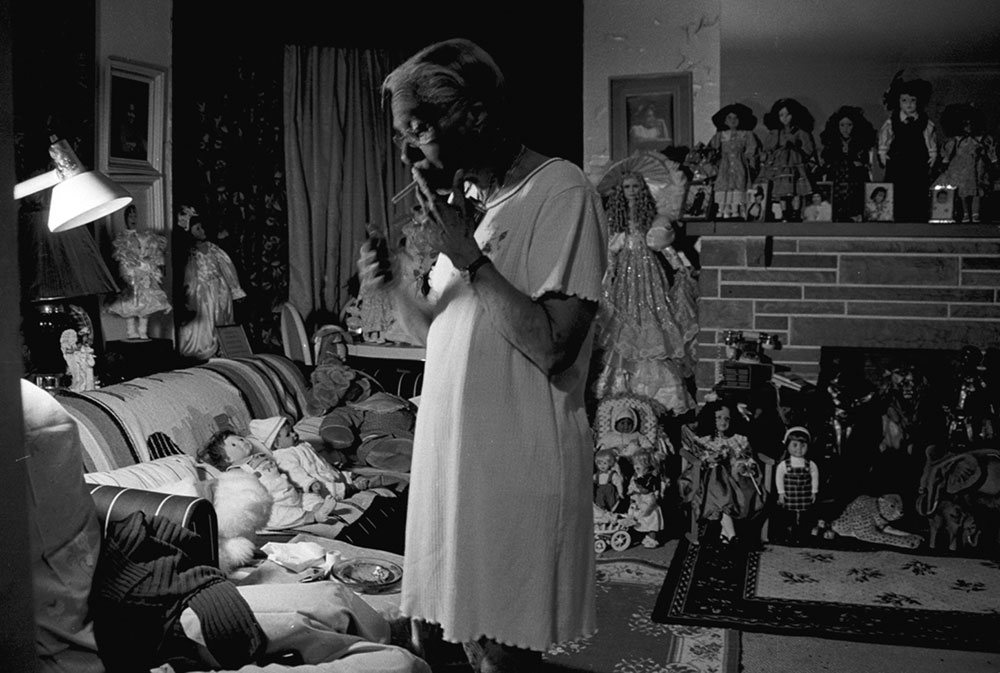
Latoya Ruby Frazier
Grandma Ruby Smoking Pall Malls, 2002
Gelatin Silver Print
24 x 28 inches
Latoya Ruby Frazier
In The Notion of Family, a series of photographs and videos, Latoya Ruby Frazier and her family bear witness to the impact of industrialism, environmental racism and oppression on Black women. Frazier particularly centers on the three generations of women in her maternal family: her grandmother, mother, and herself living in Braddock, Pennsylvania. Raised by her grandmother Ruby, Frazier’s photographs are often autobiographical. Her portraits counter stereotypes perpetuated in the media of Black women living in poverty, while also considering the holistic and insidious ways systemic racism damages a community.
Grandma Ruby Smoking Pall Malls is a black and white portrait of Frazier’s grandmother Ruby shown in profile, smoking a pall mall cigarette in her night shirt. Porcelain dolls line the shelves and floor, leaving room for walking space. Family photos adorn the walls. Frazier explained that Grandma Ruby began collecting the dolls as a form of protection after the murder of her daughter. Ruby referred to them as her guardian angels.
“The history of a place is written on the body and the landscape.” Frazier
Andrew Carnegie’s first steel mill, Edgar Thomson Works, began operating in 1875 in the Pittsburgh-area communities of Braddock and North Braddock, Pennsylvania and became one of the largest US steel mills. For decades, it employed many of the townspeople and created a thriving economy. The makeup of Braddock changed dramatically after World War II, ushered by the National Housing Act of 1934, the GI Bill (aka the Servicemen's Readjustment Act of 1944), and the resulting “white flight.” Most of the white townspeople migrated to nearby suburbs, escaping the harmful air emissions from the mill. Black people and people of color were denied that opportunity largely because of redlining - a policy of structural and systemic racism. Redlining was a government policy that intentionally furthered segregation efforts by refusing to insure mortgages in and near African-American neighborhoods. Banks, led by the Federal Housing Authority, would withhold home loans to people of color in certain “designated white” areas, and only approve loans for segregated “designated colored” areas within the redlines drawn by the FHA (Mckeever 2018). As a form of systemic racism, redlining sustains white supremacy by intentionally allowing people of color to live in devalued or damaged locations. In Braddock, that meant the townspeople continued to live exposed to harmful elements.
“...through discrimination and racial and systemic oppression, you see how black people were entrapped in that area — through redlining, and not being able to get loans from banks to move to the suburbs, how they were left behind.” Frazier
Black people and people of color disproportionately live near pollutants and absorb pollution. A study by the National Center for Environmental Assessment indicated “...that race has a stronger effect on exposure to pollutants than poverty”(Newkirk II 2008); a narrative that these communities have tried to explain with little success. Associated with environmental racism and folded into systemic oppression, is implicit bias in healthcare. Provider shortages and barriers to access are major factors in Black death, especially in Black women and Black transpeople. Frazier has said her mother has an undiagnosed neurological condition. Her mother has since stopped seeking medical help after repeated belittling and invalidation of her experience by doctors.
The toxicity from the mill degraded the health of Frazier’s family and her community for generations. Her grandmother suffered from pancreatic cancer, her mother suffers from cancer and an undiagnosed neurological condition, and Latoya suffers from lupus. These diseases can be triggered and correlated to environmental factors (Kumarathasan, P., Vincent, R. et.al 2018).
By the 1970s the decline of the steel industry, diminishing population via suburbanization, and the closure of the local hospital further devastated the town. By centering her family and neighborhood in her work, Frazier challenges that people living in poverty are more than their socioeconomic status and that oppressed peoples’ stories are important.
Although born into completely different circumstances, I find myself thinking of my maternal grandmother when I look at Grandma Ruby Smoking Pall Malls. After my family immigrated from Haiti to the states, my grandmothers, respectively, helped rear their grandchildren as their own children worked to support the family. In my family, and in many Haitian families, it is not uncommon to be raised with our grandmothers in our homes. Like Frazier, my grandmother helped raise my brother and me.
In respect to the photo, I imagine Frazier captured her grandmother in the midst of one of her bedtime rituals; cigarettes and a welcomed rest on the couch. An ashtray is placed where I imagine Grandma Ruby would sit. Her body hunched over in procedure to light and accept the smoke.
My maternal grandmother was not a smoker, but this work still takes me to memories of my grandmother’s own nighttime rituals- greasing and braiding her hair, translating the play-by-play activity of wrestling matching on tv, eating labouyi (porridge) with bread. My grandmother has overcome adversity throughout her life. She has lived through civil wars, political violence, death, immigration all while being a single mother.
I honor the labor that is done as the leader of a family. Grandma Ruby and my grandma, Madame Maca, were the matriarchs, the pillars in their respective families. And they worked hard. In this society, Black womens’ labor is erased and not celebrated nearly enough. Despite that, Black women do the thankless work. Black women helped engineer astronauts into space. Black women are teachers, makers, caretakers and builders. Black women and Black transwomen helped facilitate movements for equity and equality. This photo is a celebration of that work and it does not go unnoticed to me. So when I see a matriarch, I respect and acknowledge her for her labor, her story, her struggles, her successes and her humanity. I am not me without those who came and paved the way before me.
Bibliography + Additional Resources
- Cloonan, Ed, and Kf. “Witnessing as Critical Response: LaToya Ruby Frazier.” Glasstire, 14 Sept. 2013, glasstire.com/2013/09/14/witnessing-as-critical-response-latoya-ruby-frazier/.
- Taylor, Jamila. “Racism, Inequality, and Health Care for African Americans.” The Century Foundation, 7 May 2020, tcf.org/content/report/racism-inequality-health-care-african-americans/?session=1.
- Kumarathasan, P., Vincent, R., Blais, E., Bielecki, A., Guénette, J., Filiatreault, A., Brion, O., Cakmak, S., Thomson, E. M., Shutt, R., Kauri, L. M., Mahmud, M., Liu, L., & Dales, R. (2018). Cardiovascular and inflammatory mechanisms in healthy humans exposed to air pollution in the vicinity of a steel mill. Particle and fibre toxicology, 15(1), 34. https://doi.org/10.1186/s12989-018-0270-4
- Newkirk, Vann R. “Environmental Racism Is Real, According to Trump's EPA.” The Atlantic, Atlantic Media Company, 28 Feb. 2018, www.theatlantic.com/politics/archive/2018/02/the-trump-administration-finds-that-environmental-racism-is-real/554315/.
- New York, New Wave: the Legacy of Feminist Artists in Emerging Practices, by Kathy Battista, I.B. Tauris, 2019.
- Rattman, Jonno, and Amy McKeever. “In the Shadow of the Steel Mill.”Topic, Topic, 6 May 2019, www.topic.com/in-the-shadow-of-the-steel-mill.
- Segal, Corinne. “A Bird's-Eye Portrait of What Was Once a Thriving Steel Town.” PBS, Public Broadcasting Service, 16 Nov. 2015,www.pbs.org/newshour/arts/latoya-ruby-frazier-braddock-pennsylvania.
- https://www.npr.org/2017/05/03/526655831/a-forgotten-history-of-how-the-u-s-government-segregated-america
- Latoya Ruby Frazier
- LaToya Ruby Frazier Makes Moving Pictures | Art21 "New York Close Up"
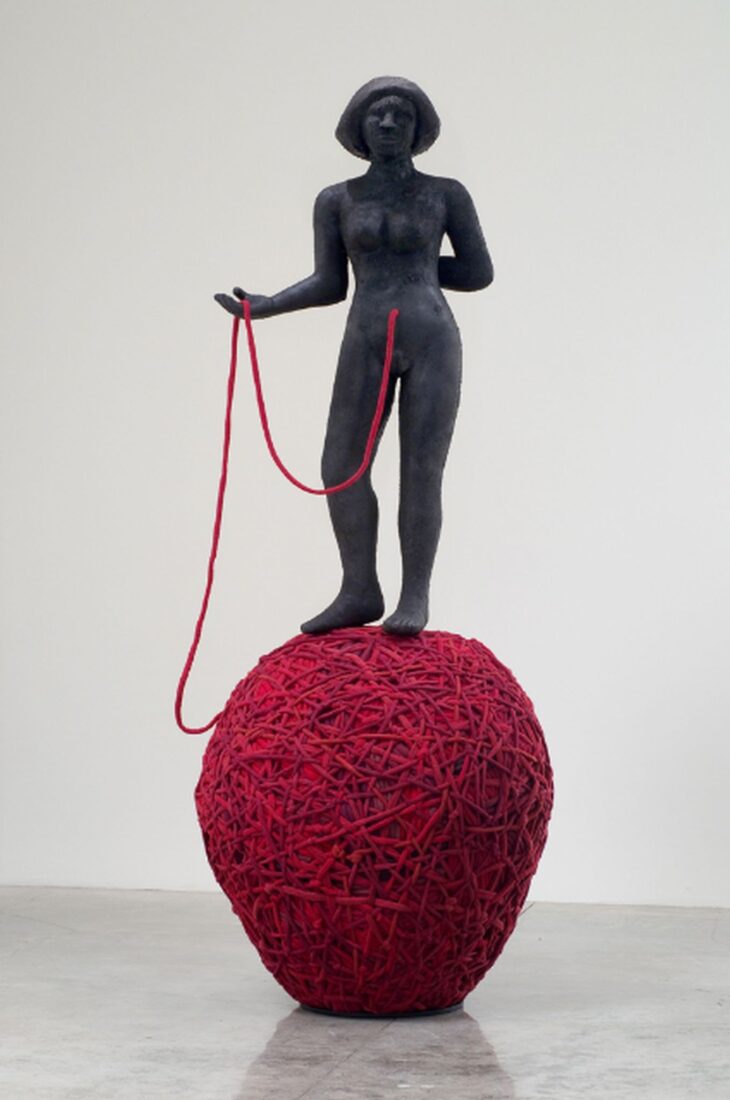
Alison Saar
Discord, 2009
Wool, steel, fiberglass, coal and Styrofoam
104 x 40 x 40 inches
Alison Saar
Last weekend, many Americans celebrated the 244th anniversary of the Declaration of Independence. As the country celebrated the birth of this nation, many chose not to partake because the rights secured by the authors were not extended to “all men” and women.
“What, to the American slave, is your 4th of July? I answer; a day that reveals to him, more than all other days in the year, the gross injustice and cruelty to which he is the constant victim. To him, your celebration is a sham; your boasted liberty, an unholy license; your national greatness, swelling vanity; your sound of rejoicing are empty and heartless; your denunciation of tyrants brass fronted impudence; your shout of liberty and equality, hollow mockery; your prayers and hymns, your sermons and thanks-givings, with all your religious parade and solemnity, are to him, mere bombast, fraud, deception, impiety, and hypocrisy -- a thin veil to cover up crimes which would disgrace a nation of savages. There is not a nation on the earth guilty of practices more shocking and bloody than are the people of the United States, at this very hour”-Fredrick Douglass
Quoted widely on Independence Day, Frederick Douglass sums up the contradiction and Black perspective of celebrating the independence of a country that did not grant freedom to enslaved peoples until almost a century later. The “unalienable rights” included in the Declaration of Independence demanded freedom for “all men”, yet implicitly excluded the rights of enslaved peoples.
“There’s something about the American experience that tears away at the black body”- Dani McClain, author
Discord by Alison Saar is a sculpture of a woman standing on a ball of yarn-like red thread. The red material is actually found blankets dyed in strips, and is attached to her navel. One of the woman’s arms holds the thread and the other is hidden behind her back holding onto a pair of scissors. A multi-disciplinary artist, Saar works in sculpture, print, mixed media and installation. Saar explains that the thread attached to the sculpture’s navel is “sort of an umbilical cord, but it’s also this mass of uterine stuff…It’s like she’s prepared to cut loose from all these things, sever herself from the past.” Influenced by her mother, artist Betye Saar, Alison Saar’s works focus on gender, racial identity issues and how racial identity is shaped by history. In this sculpture, Saar is commenting on the experience of motherhood, in particular Black motherhood.
For Black women, raising children is challenging not only due to worries for their child’s healthy development but also of fears of how white supremacy and racism will affect their children. Concerns are broad, and range in scope to racial disparities in quality and access to education and job opportunities; to higher levels of incarceration, state-sanctioned violence and discrimination related to hairstyle, dress, and language. Additionally, Black mothers have to be concerned with the pervasive perceptions that hypersexualize and adultify Black children more than their non-Black counterparts (Shapiro 2017).
Acknowledging that this society dehumanizes their youth contributes to health issues in Black mothers; i.e. children’s exposure to discrimination can harm their mothers’ health. There are physiological impacts on health as a result of white supremacy and racism on Black women’s bodies and particularly mothers’ health (Meadows-Fernandez 2020). A study published by Cynthia G. Colen, associate professor at the Department of Sociology Ohio State University, and her team reports that Black and Hispanic mothers exist in a state of high stress (Colen et. al 2019). These stressors can lead to slower blood pressure recovery, increases in inflammatory markers, and worse sleep patterns (Meadows-Fernandez 2020).
“Weathering” is a term used to describe the debilitating effects racism can have on health. According to Dr. Joia Adele Crear-Perry, president of the National Birth Equity Collaborative, weathering can cause higher rates of high blood pressure and diabetes. Women of color have the highest rates of maternal death, and regardless of socioeconomic status or education, Black mothers are the most at risk (Meadows-Fernandez 2020). These systemic stressors age Black bodies at a more rapid rate than their white counterparts’. This aging directly affects birthing outcomes. Coupled with implicit healthcare bias, Black women are four to five times more likely to die in childbirth (CDC 2019).
Although I am not yet a mother, and to be honest, might never be, I cannot deny the struggles of what it takes to provide for the healthy development of a Black child in this world. The emotional burden seems so daunting to me. If Black children are so often dehumanized, how can I feel safe to bring a Black child into this world? If all life circumstances were somehow controlled, and every mother had equal opportunities, raising children would still not be easy. But life is not controlled and the odds are stacked against Black women. The fact is that bringing a child into this world is frightening; but that fear increases and is more substantial when you are a Black mother.
The woman in Discord is holding a pair of scissors behind her back. She looks as though she is about to cut this umbilical string that holds her to this burdensome mass she stands upon. The function of the umbilical cord in the pregnant woman’s body is to provide oxygen and nutrients to the fetus. It is cut after birth once it has served its purpose. How empowering would it be to cut what tethers us; that would allow us to be free from the oppressive systems that make it more difficult to raise Black children?
Though I recognize my fears, if I focus on the positives of motherhood, I do find some relief in the beauty. Black motherhood is full of resilience, selflessness, community, and joy. I am a testament to that resiliency.
Bibliography + Additional Resources
- Andrews-Dyer, Helena. “I Wanted to Read an Article about Black Motherhood That Wasn't a Horror Story. So I Wrote It Myself.” The Washington Post, WP Company, 4 Sept. 2019, www.washingtonpost.com/graphics/2019/lifestyle/black-motherhood/.
- Colen, Cynthia G., et al. “The Intergenerational Transmission of Discrimination: Children’s Experiences of Unfair Treatment and Their Mothers’ Health at Midlife.” Journal of Health and Social Behavior, vol. 60, no. 4, Dec. 2019, pp. 474–492, doi:10.1177/0022146519887347.
- McClain, Dani. “What It's Like to Be Black and Pregnant When You Know How Dangerous That Can Be.” The Nation, 13 June 2018, www.thenation.com/article/archive/what-its-like-to-be-black-and-pregnant-when-you-know-how-dangerous-that-can-be/.
- Meadows-Fernandez, A. Rochaun. “The Unbearable Grief of Black Mothers.” Vox, Vox, 28 May 2020, www.vox.com/first-person/2020/5/28/21272380/black-mothers-grief-sadness-covid-19.
- “Racial and Ethnic Disparities Continue in Pregnancy-Related Deaths.” Centers for Disease Control and Prevention, Centers for Disease Control and Prevention, 6 Sept. 2019, www.cdc.gov/media/releases/2019/p0905-racial-ethnic-disparities-pregnancy-deaths.html.
- https://www.courant.com/sdut-lifes-dualities-morphed-into-art-2011feb05-htmlstory.html
- https://www.luxartinstitute.org/news/alison-saar-makes-the-personal-universal-in-her-remarkable-art/ https://www.naacp.org/criminal-justice-fact-sheet/
- https://www.npr.org/2020/05/12/851769833/she-s-challenging-you-alison-saar-s-sculptures-speak-to-race-beauty-power
- https://www.pbs.org/wgbh/aia/part4/4h2927.html
Paula Wilson
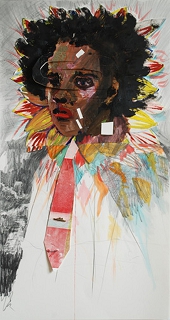
Paula Wilson’s “Not Yet Titled 18” is a portrait of a Black girl in oil, watercolor, and pencil. The subject’s expression is somber, her red lips are frowning and her gaze is focused out of frame. Red and yellow petals frame her head and the undertone of the piece is subdued and dark. Wilson disrupts the portrait by cutting into the paper, leaving small holes, and one such cut out circling the eyes, brings focus to the subject’s melancholic gaze.
Wilson received her MFA at Columbia University and her BFA from Washington University. She is a mixed media artist that engages in themes about the female persona, identity and cultural history in her work.
“For me, the drive is the desire to see archetypes that I can relate to as a woman, as an American, and as a person of color. When I set out to make a work of art I am particularly interested in depicting multiple viewpoints, multiple perspectives within a single picture plane. It is one of the things that excites me when I make two-dimensional art.” Paula Wilson
I was raised to be a private individual. My family immigrated to this country from Haiti; my father in the late 70s and my mother in the 80s. Our family’s survival tactic was focused on quietly acclimating. I grew up with a positive sense of self in relationship to the world I occupied. I was secure in my identity as a first generation Haitian American. I was sheltered but my life was not without hard moments. Even so, I felt safe in my community.
My family is big on keeping our business to ourselves. My parents were reserved and as immigrants to this country, they felt it safer not to invite unnecessary attention, life was difficult enough. My parents explained to me that inviting others into our “problems” or oversharing can come with negative results. Not unique to me, but as a child, I learned to curb my tendency to blurt out or overshare. When I was younger, I thought it was silly, “who cares about what we do?” I never questioned them. I obliged. Being born and raised in this country, I did not understand their reasoning. I felt I had every right to vocalize and be as loud as my peers I had witnessed.
As others in this country, we were vulnerable. My parents wanted us to be safe and they did all that they could to ensure this safety. They made a difficult decision to raise children in a foreign land, learn a new language and adopt new cultural customs. They felt the best way to ensure their children’s safety was to assimilate and to be seen and not heard (their favorite directive for how we had to behave as children).
When I reflect on this piece by Paula Wilson, the flower petals and the subject’s grave demeanor stand out. The petals and red lips suggest a gender expressed female. Her eyes and frowning lips convey unhappiness. I wonder about her pensive, reserved appearance, what is causing this expression? What is she wanting to express but not able to? Had she been taught to be seen and not heard too?
I view art as a source for introspection. It is an essential part of my process to digest and analyze my emotions when encountering a work of art. In this work, I identify with this girl with her natural hair and quiet frown. She is a mirror to how I feel at the moment. I am pensive, angry and impassioned. I am confounded by performative acts of solidarity, disregard for marginalized peoples and dismissive actions that still uphold white supremacy. Why is it debatable to fight for Black lives?
The recent heightened attention to racial disparities and the struggle for equitable civil rights is important to the struggle yet there is so much more work that needs to be done. With this sudden attention and more awareness, I have shifted my focus more on my community and funding my community.
My objective with this essay project is to center my personal perceptions to respective pieces in the collection, but also to stand loudly in my narrative and share my truths, as artists do inherently with their work. Being so open and vulnerable is new and frightening to me. Our stories define us and it is important for us to be open and share. That’s why this project is so valuable to me. The power of narrative can unite us. I was taught not to disturb or stir the pot, lest I invite danger. But if my thoughts and truths are deemed dangerous, so be it. Now is not the time to be quiet. Now is the time to draw attention. Now is the time to take up space. We do not need to suffer in silence. I know I am not the only one who feels this way, so I will share.
Bibliography + Additional Resources
Still Do I Keep My Look, My Identity...
Each body has its art, its precious prescribed
Pose, that even in passion's droll contortions, waltzes,
Or push of pain--or when a grief has stabbed
Or hatred hacked--is its and nothing else's.
Each body has its pose. No other stock
That is irrevocable, perpetual,
And its to keep. In case or in shack.
With rags or robes. Through good, nothing, or ill.
And even in death a body, like no other
On any hill or plain or crawling cot
Or gentle for the lilyless hasty pall
(Having twisted, gagged and then sweet-ceased to bother),
Shows the old personal art, the look. Shows what
It showed at baseball. What it showed in school.- Gwendolyn Brooks
About Tayina Deravile
Tayina Deravile holds a Bachelor of Science degree in Psychology from the University of Central Florida and a Master’s degree in Mental Health Counseling at Nova Southeastern University. While attending graduate school, Tayina began her career in arts administration in Fort Lauderdale.
She is currently the Gallery Manager at Girls' Club, the only private collection in the world that primarily exhibits contemporary art by women, and the Director of Arts Administration and Community Engagement at FATVillage Arts District, a nonprofit that strives to generate an art community that is inclusive.
Tayina sits on the Greater Fort Lauderdale Chamber of Commerce Cultural Arts Committee and The Association of American Cultures. She also has been the Special Projects Fellow at Prizm Art Fair, an art fair that happens during Basel Miami Art Week that exhibits international artists from Africa and the global African Diaspora since 2017. Furthermore, she is a co-partner in Estuary an arts organization whose mission is to connect South Florida's African diaspora through arts programming. She believes in the unique healing power the arts can foster in mental/emotional well being.
